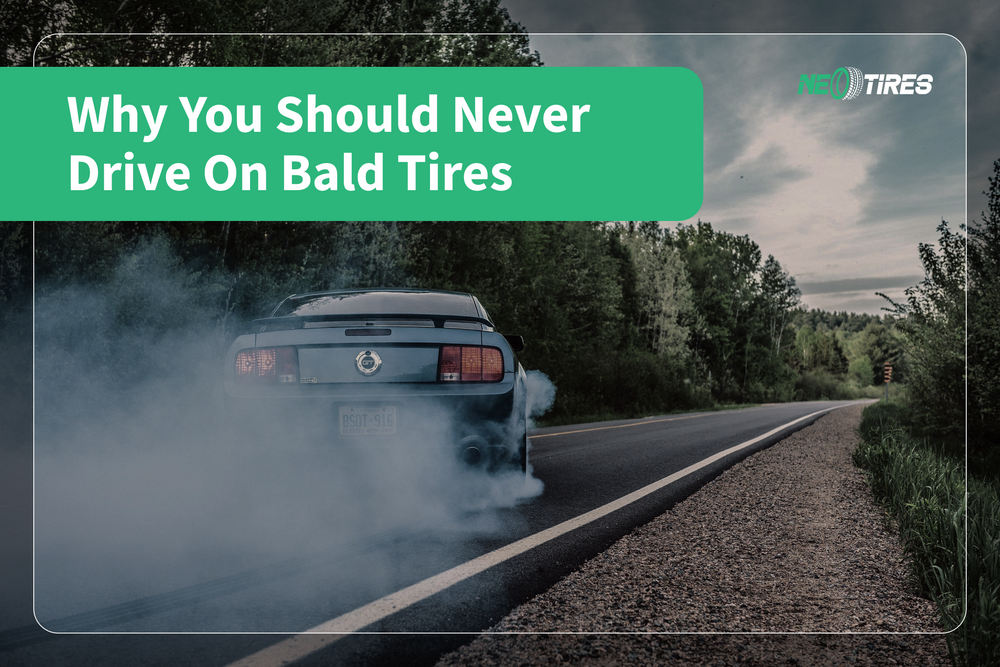The performance of your vehicle is directly proportional to the quality of your tires. If you want to do your car a favor, get a set of performance tires to benefit from efficient traction, a stable grip, and a comfortable ride.
Being exposed to a set of influential factors, tires wear out over time. This is a natural phenomenon that we can expect from the moment we buy a brand-new set. Once the car accumulates mileage, the tires wear harder and harder until they become bald. Unfortunately, many drivers do not pay much attention to this condition, believing that the risk is minimal. But is it really like that? I propose to discuss this topic in this article to better estimate the risks.
What Makes Tires Bald?
Most drivers believe that a tire can become bald just because it is subject to permanent road exposure. They are right, but only partially. Various reasons lead to a tire becoming bald. And their awareness is the first step in preventing them from becoming bald. In addition to natural wear that leads to tire balding, here are other influencing factors:
-inappropriate tire pressure. Regardless of whether they are over- or under-inflated, the tires are subject to additional stress, generating uneven wear. Over time, this uneven wear leads to tire balding;
-maintenance issues. Drivers who neglect their tires have them worn much earlier. Lack of proper tire maintenance leads to tire misbalance and tread damage;
- tire misbalance and misalignment. Disproportionality between tires or between wheels severely affects the texture of the tires over time. These cause rolling issues, traction difficulties, and uneven tire wear. And uneven tire wear, in turn, is the frequent cause of tire balding;
-vehicle overloading. If the weight of the body does not correspond to the load capacity of the tires, they tend to overheat. Overheating of the tires leads to their expansion, generating deformities in their structure. One of the consequences of the deformity is tire balding;
- the condition of the road. Road sections that make traction difficult, such as dirt, gravel, debris, or other rough barriers impact tire wear, accelerating the tire balding process;
- driving style. Some drivers love to experiment to the maximum with the capacity of their cars. Thus, they subject the car to drifting, aggressive braking, burnouts, or sudden accelerations. All this leads to inevitable tire balding at an extremely fast rate.
Is A Good Tire Better Than A Bald One?
Many drivers don't really see how an optimal tire prevails over a bald one. The answer lies in the structure of the tire. An optimal tire has a sufficiently deep tread to cope with challenging roads. Also, an optimal tread means a complex architecture of grooves that effectively removes water and dirt, as well as ensures a stable and safe grip, eliminating hydroplaning.
In contrast, a bald tire has almost no tread. It is wiped down to the level of the rubber, remaining only an almost flat texture. In these circumstances, the tire definitely loses the ability to establish an effective grip on the road. The friction force decreases substantially and the vehicle becomes unstable in contact with the road. Effects such as hydroplaning and traction loss are very likely.
What Are The Risks of Driving With Bald Tires?
If you read the international statistics, you would be surprised to see how many accidents occur specifically because of bald tires. Driving with such tires is extremely dangerous because the vehicle becomes extremely sensitive to handling. It is better to avoid a ride with bald tires at all costs than to expose yourself to imminent risk. Here's what can happen, if you still take the risk...
#1 Punctures
As the tire treads wear down, it becomes much thinner and more sensitive to pressure, stress, and load. Even the smallest pebble can cause damage to the thin tire, causing a puncture with a subsequent flat tire in the best scenario, and a blowout in the worst one. Delaying tire replacement is not a good idea at all.
#2 Poor Snow Performance
You risk turning your drive into an "ice-skating" experience if you dare to go with bald tires in the snow. The tires do not have special sipes to ensure a stable grip during the winter. Your vehicle will slide like a sled and you can lose control of it in seconds.
#3 Hydroplaning
Even if you live in warm areas, your ride will not be safe anyway due to hydroplaning. Bald tires lack the necessary grooves for the efficient removal of water from the tire channels. Consequently, the grip is extremely weak on wet surfaces making your car hydroplane. Your tires will literally drown in water because they don't have enough ability to disperse the water. You will lose control over the vehicle because the water will severely impact its stability on the road.
#4 Tire Burst
A tire burst is very likely not only because the tire is thin. Another reason is that heat is generated much faster and in the absence of the treads that serve as ventilation between the tire and the road, they can be one step away from bursting. I think you know how dangerous a tire burst in the middle of the road is. In such a scenario, you will likely lose control of the car due to the reduced reaction time.
#5 Too Long Braking Distance
Manufacturers place great emphasis on tire treads specifically to increase the braking ability of the vehicle. This means that the tire tread is directly proportional to the braking distance. And what braking distance can a tire that has no treads at all offer? You realize that the margin increases dramatically, which leads to an imminent risk of collision with other obstacles.
These are only a small part of the outcomes that can occur when driving with bald tires. Are you sure you want to take all these risks?!
Can You Reduce Bald Tire Risks?
No, there are no ways to reduce the risks of bald tires. The only thing you have to do in this case is to change the tires as soon as possible.
You need to inspect your tires as often as possible to detect possible problems early. The pressure, the depth of the treads, signs of dry rot, and tread wear - all require a regular inspection. Unfortunately, many drivers still do not consider bald tires as an imminent risk. And the worst thing is that they not only expose themselves to risk but also other drivers as well.
Postponing tire replacement leads to an increase in the risks I mentioned recently. You must be a responsible driver. The maximum admissible legal limit of tread wear is 2/32''. But I insist that you replace them before you reach this limit, for your safety. It is very easy to check the condition of your tires. Either use the "penny" method or contact a specialist in the field. After all, a bald tire can be seen with the naked eye because its external structure is visibly worn.
Bald Tires: FAQs
Is It OK To Drive With Bald Tires?
It's not at all safe to drive on bald tires. Your tires are those that ensure confident performance, reliable traction, safe braking, and stable driving. If they are in poor condition, all performance aspects will be significantly reduced. Bald tires are dangerous because they can fail at any moment and do not provide safe driving. They will hydroplane in the water and slide on the snow, putting your driving safety at risk.
What Defines A Bald Tire?
Each tire has a tread that must have a certain depth to provide enough safety and performance. If the tread wears down to a depth of 2/32'' and below, it becomes unsafe for further driving. A bald tire doesn't provide either grip or traction on different roads, which increases the risk of accidents.
How Long Will Bald Tires Last?
No one can estimate the longevity of a bald tire. This can fail at any time causing a blowout. Bald tires are also dangerous because they will make your vehicle understeer and brake very hard. With this in mind, you should never rely on the longevity of bald tires but rather on awareness of the risks.
Why Do People Use Bald Tires?
Bald tires can be an option only in the context of car racing. Professional racers rely on bald tires because they provide great traction and grip. But this is only valid for special racing conditions where the roads are clean and smooth. In usual driving conditions, bald tires are dangerous because they are not reliable enough to cope with ordinary road conditions.
Do Bald Tires Affect Speed?
The balder the tires, the more the traction and acceleration decrease. You can never count on bald tires when accelerating. So speeding should be excluded in this context. If for some reason you drive on bald tires (which we hope You Don't), we recommend that you keep a speed as low as possible. Even so, you have no guarantees of tire safety even at low speeds and tire failure is still at imminent risk.
Is It Worse To Have Bald Tires On Front Or Back?
First of all, you should never drive on bald tires. The risks are too great to assume. If, however, for some reason, you do run on such tires, the best you can do is to mount them on the front axle. In other words, the tires in the best condition must go on the rear, regardless of the vehicle traction system. Bald tires on the back are likely to make the vehicle oversteer, hydroplane, skid, or spin out. So, you need healthier tires on the rear to better control your vehicle in dangerous conditions.
Why Trust Us?
Several reasons can make you trust us. Here are some of them:
- we have extensive experience in the tire industry;
- we collaborate with reputable brands in the tire market;
- we negotiate prices with them to offer attractive tire deals;
- we have qualified mechanics, testers, content writers, and assistants in our team;
- tires are our die-hard passion. That's why we love what we do and we have enough motivation to provide high-quality service, assistance, and products.
Feel free to contact us anytime. We are happy to share our tire knowledge with you, knowing that this will help you improve your driving experience. Drive safe and choose your tires wisely!





